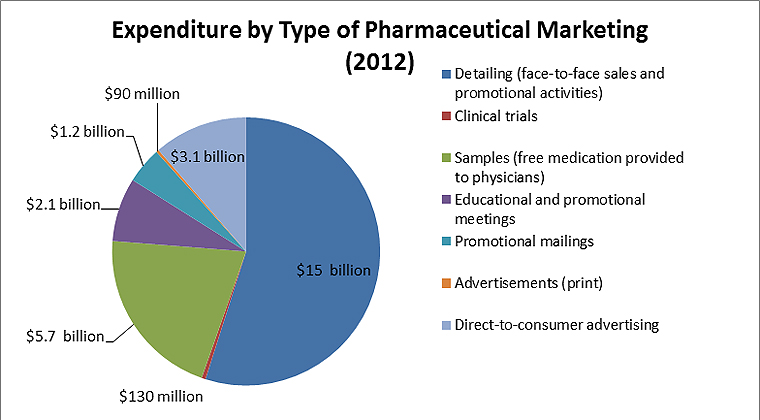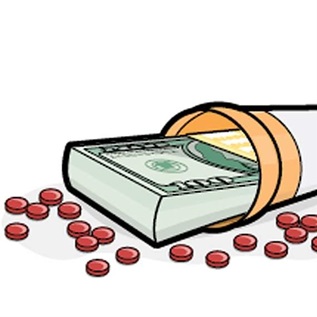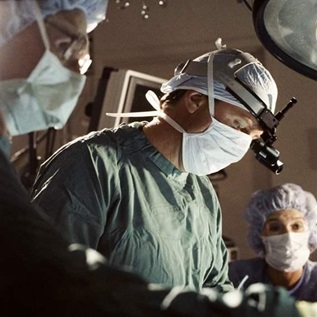Persuading the Prescribers: Pharmaceutical Industry Marketing and its Influence on Physicians and Patients
In 2012, the pharmaceutical industry spent more than $27 billion on drug promotion1— more than $24 billion on marketing to physicians and over $3 billion on advertising to consumers (mainly through television commercials).2 This approach is designed to promote drug companies' products by influencing doctors' prescribing practices.3
How Does the Pharmaceutical Industry Market its Drugs and How Much Does It Spend?

© 2013 The Pew Charitable Trusts
Source: Cegedim Strategic Data, 2012 U.S. Pharmaceutical Company Promotion Spending (2013).
Direct Marketing
Detailing: This marketing approach refers to face-to-face promotional activities directed toward physicians and pharmacy directors. Pharmaceutical representatives typically visit doctors to pitch their drugs. Detailing also includes taking doctors out for meals and giving them gifts in the form of medical textbooks. As of 2012, approximately 72,000 pharmaceutical sales representatives were employed in the United States.4
Samples: Providing free medication samples to physicians has been shown to cause significant increases in new prescriptions for the promoted drug.5 Although companies assert that samples benefit indigent patients, research indicates that most are given to insured patients whose medications are covered.6 Indeed, patients who are given samples ultimately have higher prescription costs than those who do not receive them because they are then prescribed the sampled drug rather than its less-expensive generic alternative.7
Educational and Promotional Meetings: Sales representatives invite doctors to meetings during which industry-paid physicians discuss the use of particular drugs. These speakers are often leaders in their fields, which increases the draw. According to an analysis by ProPublica, an independent investigative news organization, eight pharmaceutical companies provided more than $220 million in speaker payments to physicians in 2010.8 The companies often host these events at restaurants and provide meals to physicians who attend.9
Promotional Mailings: Pharmaceutical companies send unsolicited promotional materials to most doctors' offices. Typically, these brochures tout a drug's benefits and positively describe the results of recent clinical trials, which are often funded by the same company. One study found that these materials were highly biased in favor of the company's products, mainly because they selectively reported trials in which the sponsored drug outperformed that of competitors.10
Journal and Web Advertisements: These advertisements are standard promotional techniques that provide an important source of revenue for medical journals. The accuracy of statements in such ads is regulated by the U.S. Food and Drug Administration, or FDA. According to one study, journal advertising generated the highest return on investment of all promotional strategies employed by pharmaceutical companies, with returns ranging from $2.22 to $6.86 per advertising dollar spent between 1995 and 1999.11 In April 2009, FDA warned 14 major drugmakers for running search ads for many of their products that highlighted the products' effectiveness without noting any of their risks.12
Direct-to-Consumer Advertising: In 1997, FDA issued guidance that enabled pharmaceutical companies to more easily advertise to the public. Since then, spending on these direct-to-consumer ads has nearly quadrupled.13 One study showed that 43 percent of respondents thought that only “completely safe” drugs were allowed to be advertised. Direct-to-consumer advertising has proved effective in motivating patients to ask for the branded product, even when generic equivalents exist.14 Furthermore, these ads have encouraged one-third of respondents to speak to their doctors about the promoted drug and one-fifth to request the prescription.15 In one study, doctors were more likely to prescribe a branded antidepressant when asked for it by name than when patients didn't specify which treatment they wanted.16
The United States and New Zealand are the only member countries of the Organization for Economic Cooperation and Development in which drug companies can advertise prescription drugs directly to consumers. (The organization includes 34 of the world's most advanced and emerging nations in North and South America, Europe, and Asia.)
Indirect Marketing
Continuing Medical Education (CME): In 2011, the pharmaceutical and medical device industries provided 32 percent of all funding for continuing medical education courses in the United States—$752 million out of $2.35 billion.17 To prevent these courses from functioning as veiled marketing, they are regulated by the Accreditation Council for Continuing Medical Education. However, a 2007 Senate Finance Committee report found that “drug companies have used educational grants as a way to increase the market for their products in recent years.”18
Grants to Health Advocacy Organizations (HAO): Patient advocates can mobilize large numbers of people on behalf of a specific issue, often to the benefit of drug companies that manufacture treatments for their diseases. One study found that organizations that had received grants from pharmaceutical manufacturers often endorsed the companies' positions, while groups that had received minimal financing focused their advocacy on drugs' potential side effects.19
References:
1 Cegedim Strategic Data, 2012 U.S. Pharmaceutical Company Promotion Spending (2013), http://www.skainfo.com/health_care_market_reports/2012_promotional_spending.pdf.
2 Ibid.
3 Ashley Wazana, “Physicians and the Pharmaceutical Industry: Is a Gift Ever Just a Gift?” Journal of the American Medical Association 283 (2000): 373–80.
4 Jonathan D. Rockoff, “Drug Reps Soften Their Sales Pitches,” Wall Street Journal (Jan. 10, 2012), http://online.wsj.com/news/articles/SB10001424052970204331304577142763014776148.
5 M.Y. Peay and E.R. Peay, “The Role of Commercial Sources in the Adoption of a New Drug,” Social Science and Medicine 26 (1998): 1183–9.
6 Ibid.
7 C.G. Alexander, J. Zhang, and A. Basu, “Characteristics of Patients Receiving Pharmaceutical Samples and Association Between Sample Receipt and Out-of-Pocket Prescription Costs,” Medical Care 46 (2008): 394–402.
8 Charles Ornstein, Tracy Weber, and Dan Nguyen, “Piercing the Veil, More Drug Companies Reveal Payments to Doctors,” ProPublica, Sept. 7, 2011, accessed May 21, 2012, http://www.propublica.org/article/piercing-the-veil-more-drug-companies-reveal-payments-to-doctors. The eight companies were the only ones to have provided a full year's worth of data that could be analyzed.
9 Charles Ornstein, “Doctors Dine on Drug Companies' Dime,” ProPublica (Sept. 7, 2011), http://www.propublica.org/article/doctors-dine-on-drug-companies-dime.
10 C. Wick et al., “The Characteristics of Unsolicited Clinical Oncology Literature Provided by Pharmaceutical Industry,” Annals of Oncology 18 (2007): 1580–82, http://annonc.oxfordjournals.org/content/18/9/1580.short?rss=1.
11 Scott Neslin, ROI Analysis of Pharmaceutical Promotion (RAPP): An Independent Study (2011), http://www.pharmxpert.net/web/board/b_ne01upload/RAPPì¡°ì¬.pdf.
12 Food and Drug Administration Division of Drug Marketing, Advertising, and Communications, letters to Biogen Idec, Sanofi Aventis U.S., Bayer HealthCare Pharmaceuticals, GlaxoSmithKline, Forest Laboratories Inc., Cephalon Inc., Johnson & Johnson Pharmaceutical Services, Pfizer Inc., Novartis Pharmaceuticals Corp., Genentech Inc., Boehringer Ingelheim Pharmaceuticals Inc., Merck & Co., Hoffmann-La Roche Inc., and Eli Lilly and Co. (April 2009), http://www.fda.gov/Drugs/GuidanceComplianceRegulatoryInformation/EnforcementActivitiesbyFDA/WarningLettersandNoticeofViolationLetterstoPharmaceuticalCompanies/UCM055773.
13 Julie M. Donohue, Marisa Cevasco, and Meredith B. Rosenthal, “A Decade of Direct-to-Consumer Advertising of Prescription Drugs,” New England Journal of Medicine 357 (2007): 673–81, http://www.nejm.org/doi/full/10.1056/NEJMsa070502#t=articleTop.
14 M. Peyrot, N.M. Alperstein, D. Van Doren, and L.G. Poli, “Direct-to-Consumer Ads Can Influence Behavior; Advertising Increases Consumer Knowledge and Prescription Drug Requests,” Marketing Health Services 18 (1998): 26-32.
15 Robert A. Bell, Richard L. Kravitz, and Michael S. Wilkes, “Direct-to-Consumer Prescription Drug Advertising and the Public,” Journal of General Internal Medicine 14 (1999): 651–57.
16 Richard L. Kravitz et al., “Influence of Patients' Requests for Direct-to-Consumer Advertised Antidepressants: A Randomized Controlled Trial,” Journal of the American Medical Association 293 (2005): 1995–2002.
17 Accreditation Council for Continuing Medical Education, ACCME 2010 Annual Report Data (2011), http://www.accme.org/news-publications/publications/annual-report-data/accme-annual-report-data-2010.
18 Noelle C. Sitthikul, “Senate Finance Committee Releases Report on Drug Industry CME Grants,” FDA Law Blog, May 8, 2007, http://www.fdalawblog.net/fda_law_blog_hyman_phelps/2007/05/senate_finance_.html.
19 Jessica Marshall and Peter Aldhous, “Patient Groups Special: Swallowing the Best Advice?” New Scientist (Oct. 27, 2006), 18–22.





